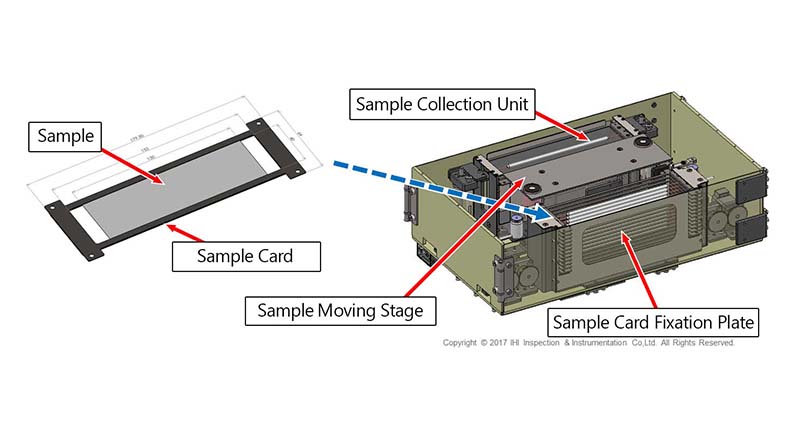
One of the most important technologies for human activities in space is the fire safety technology. Contrary to combustion on Earth, combustion of solid fuels in a microgravity environment has shown many important characteristics which had not been known. For example, flammable limit of solid fuels could be extended to lower oxygen concentration in microgravity environment, comparing with that in normal gravity. The importance of fire safety technology in space is increasing.
The Solid Combustion Experiment Module (SCEM) is designed to acquire data on the limiting oxygen concentration that flame spread over solid fuels is sustained. Also, it is possible to obtain the limiting electric current that self-ignition of the insulated wires due to short-circuit occurs. Combustion characteristics of solid materials in the microgravity environment where no buoyancy-induced convection occurs as wells as the effect of gravity on the combustion limit of solid materials will be identified through studies by SCEM.
The effects of various factors, including type and shape of the materials used, direction and velocity of external flow, and ambient pressure, on the combustion of solid materials will be assessed. Such studies will contribute to actions taken for fire safety during next-generation space operations.
- Solid Combustion Experiment Module : SCEM [3.4 MB]PDF
Sketch of Experiment
SCEM is to be mounted on the Multi-purpose Small Payload Rack (MSPR) installed in the laboratory of the Japanese Experiment Module (JEM) "Kibo"/International Space Station (ISS) to be used as experimental equipment. SCEM is composed of elements including combustion vessel, experiment insert, camera units and power and communications control unit. These elements must be assembled in the Work Volume (WV) in MSPR, a space dedicated to experimental devices loading to be ready for experiments. The oxygen for combustion experiments is supplied from the gas cylinder installed in a Small-scale Experiment Area (SEA). The oxygen is led through the gas supply tube provided between WV and SEA.
All the assembling work for SCEM is carried out by the astronaut(s). After the assembling work is complete, experiment-related remote-controlled operations are conducted by the personnel on Earth at the Tsukuba Space Center (TKSC).


(approximate dimensions: 900 mm (W), 600 mm (H) and 700 mm (D))
Configuration of SCEM
Combustion Vessel and Experiment Inserts
The combustion vessel is designed to contain experiment inserts for different types of experiment samples. These experiment inserts are equipped with a circulation fan. This component enables the combustion vessel to be used as a wind tunnel. The combustion vessel has an observation window through which the combustion experiment can be monitored with cameras.

Two types of experiment insert are available: Experiment inserts 1 and 2. The experiment insert 1 is designed for samples of electrical wire and the experiment insert 2 for samples of flat plate. Replacement work for the experiment inserts and the components including ignitor as well as experiment samples to be used in the experiment inserts is carried out by the astronaut(s).
It is possible by the insert 1 to burn the wire sample with continuous winding. The wire sample is wound around a sample reel and it reaches up to 80 m. Combustion phenomena of the wire sample are observed by the cameras set around the combustion vessel, as shown in figure 8. If the flame spread rate and the sample winding speed is different, it is difficult to achieve proper observation and combustion experiment with long time. So, the flame spread rate is automatically analyzed based on the video images. Then, the sample winding speed is controlled so that it is equivalent to the flame spread rate in the opposite direction. As a result, the spreading flame is kept around the center position of the camera view.
Experiment Insert 1
| Sample | Electrical wire samples |
| Igniting method | External ignition with ignitor, or electric power feed ignition with power electrodes (two methods selectively available by component replacement) |
| Sample feed method | Sample wound around a sample reel is fed/unwound by a sample feed mechanism. |
| Replacement of samples | Astronaut(s) assume(s) the replacement work for every sample reel. |

Experiment Insert 2
| Sample | Flat plate samples |
| Igniting method | External ignition with ignitor |
| Sample feed method | A sample card set in a cartridge is automatically loaded one-by-one with a sample feed mechanism into the space where the combustion experiment is conducted. Upon completion of each experiment, the sample card is automatically put into the recovery cartridge prepared on the opposite side of the sample feed mechanism. |
| Replacement of samples | Astronaut(s) assume(s) the replacement work for every sample cartridge. |


Observation System
Five cameras are installed around the combustion vessel to observe the combustion phenomena: three visible image cameras, one high-speed camera and one infrared camera. Figure 8 shows the installation layout for the cameras. Still image and video data captured with these cameras can be downlinked for checking to TKSC by a remote control from the ground.

Unless specified otherwise, rights to all images belong to ©JAXA



